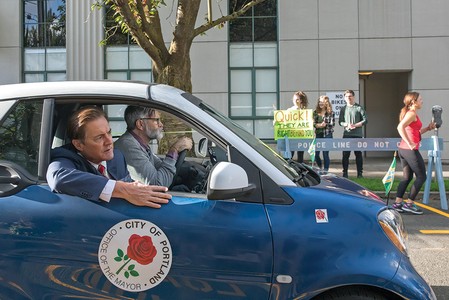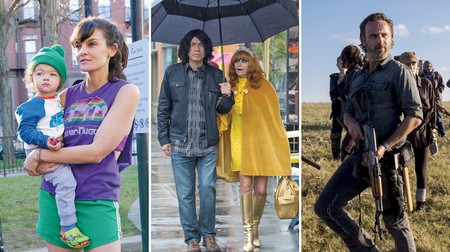‘SMILF,’ ‘Portlandia,’ ‘Walking Dead’ Aided by Location Authenticity
By Malina Saval
LOS ANGELES (Variety.com) – In real estate, location is everything, and that’s equally true of the TV business, where tax incentives, production costs and travel logistics can make the difference between whether a series set in Boston is actually shot in Boston or on a Paramount Studios soundstage. There was a time, in fact, when Los Angeles and New York were dueling hubs for small-screen productions, when if you wanted to carve out a career in TV you had to live in either city. There were no filming locations, no post-production houses. Then came cities including Vancouver and Toronto. And then Chicago, where such series as “Shameless,” “Suits,” “The Chi” and “Empire” shoot, adding an aesthetic authenticity to the storyline and poetic pulse of each show. More recently, similar up-and-coming hubs have been formed in places from coast to coast.
Portland, Ore., is a city whose reputation and identity is almost singularly informed by IFC’s “Portlandia,” the Emmy-winning sketch-comedy series created by Fred Armisen, Carrie Brownstein and Jonathan Krisel that ended its eight-season run this year.
“When Fred and Carrie and Jon initially made that first season of ‘,’ the dream was that it would become this culturally relevant touchpoint for the Pacific Northwest,” says Christine Lubrano, senior vice president of original programming at IFC. “I think we were all very aware that we were making a very little show at the time, so that was very much a dream. But it is a dream come true. The cultural relevance of ‘Portlandia’ and what it’s done for Portland is really incredible and speaks to not only the people creating ‘Portlandia,’ but Portland itself as a city.”
Before the series aired, Portland was a city known for its spectacular rose garden and dewy, thickly forested outskirts, plus Voodoo Doughnut and Powell’s Books. Thanks to “Portlandia,” the town’s outlandishly narcissistic hipster scene, vegan food culture and ecoterrorists protesting animal testing at a local makeup factory, get their respective due praise.
“Portland is really the third character of ‘Portlandia,’” says Lubrano. “In a lot of ways it is an over-heightened representation of itself, but the portrayal of Portland is incredibly authentic within the framework of this magical world of ‘Portlandia’ Carrie, Fred and Jon have created. There aren’t a lot of inaccuracies — it’s just the heightened versions of what actually exists in that wonderful city. It would be disingenuous for us to shoot ‘Portlandia’ in any other city than Portland.”
Austin, Atlanta and Boston are likewise cementing themselves as go-to spots for several critically and commercially successful series, from AMC’s zombie juggernaut “The Walking Dead” to “Brockmire” (IFC) to “SMILF,” creator and star Frankie Shaw’s comedic take on single motherhood in Southie, the signature nickname for South Boston, a neighborhood known for its strong Irish-Catholic roots, rowdy Irish pubs and fierce local pride, and famed (and now incarcerated) mob boss Whitey Bulger.
| IFC’s ‘Portlandia’ has changed the perception of the Oregon city and put it on the map in a massive way for audiences all across the country. Augusta Quirk/IFC |
“’s” pilot was shot in Boston, where Shaw is from, and the rest of the season was filmed mostly in L.A., with only two visits back east. But maximizing the authenticity factor was important to Shaw, who grew up both in Brookline, a leafy affluent suburb just outside Boston proper, and Southie, where her aunts and cousins lived. For season two, on the heels of “SMILF’s” two Golden Globe nominations, Shaw made a heavy push to locate the series full time in the Massachusetts capital.
“There are some iconic Boston landmarks that were important that we have in there,” says Shaw. “My grandmother would walk to Castle Island every morning and so it was important that we include that, and then Joseph’s Bakery is the staple, and I wanted to shoot there rather than in some random diner or chain. I think once we’re settled there for season two, Boston is really going to become more of a character.”
Although she admits it’s a “pretty big deal” to move everything across the country, Shaw says there are many advantages to shooting in the place her show is actually set, least of all that “the light quality is so much better.”
When they shot in L.A., Shaw says, there were often palm trees in the background, which couldn’t have been more inauthentic to Boston’s look. “Then we’d be shooting in Boston and I’d have to cut the episode [to match] what we shot in L.A.,” she says. “Now, there’s like this flow to everything.”
But furthermore for the vibe of the show, Shaw says, “Boston is a place where loyalty and friendship is a really big thing,” and shooting in the actual town allows her to feel that camaraderie when she’s working with the crew. “They know I’m one of them, so to speak, and I really appreciate that,” she says.
Since most of season one was shot in L.A., the department heads on “SMILF” are plucked from California, but Shaw has since curated a below-the-line crew from Boston for the second season. And since Boston offers a tax credit, notes Shaw, she “got to bring a bunch of jobs to the city.”
“Shooting in a place and a setting that allows the story to come alive has made the viewing experience much more enjoyable.”
Christine Lubrano
There are many upsides to shooting outside of an L.A. or New York soundstage, says Lubrano: “Shooting in a place and a setting that allows the story to come alive has made the viewing experience much more enjoyable.”
AMC’s “” and its spinoff “Fear the Walking Dead,” which shoot in Austin and Atlanta respectively, are an interesting example of how two cities can evoke different atmospheric vibes meant to represent different, yet related, scripted locates.
“Choosing any location is really creatively driven,” says Stefan Reinhardt, president, production and finance, AMC Studios. “We started with ‘Walking Dead’ in 2010 in Atlanta, and with ‘Fear,’ we made a creative decision to shoot in Austin to show that the two storylines were in different places. We wanted a different look for the show. …The point is to show that the series has all these different feels, that there are different [zombie] apocalypses affecting different parts of the world.”
Incentives to shoot on location, financial and otherwise, lead to an “influx of talent,” says Reinhardt.
“It’s what makes production possible in these markets, so they become like these hubs,” he says.
Other series shooting in Atlanta include the CW’s “Black Lightning” and “Dynasty” and FX’s aptly titled “Atlanta.” FXX’s “Archer” also has its animation studio in the southern city.
The larger these hubs are, the more like L.A. or New York they may become.
Lubrano describes Georgia as “Hollywood South” already. And that just means producers may have to continue to expand their search to find new places in which to shoot.
“The real challenge of Atlanta — and this is a blessing and a curse — is that there is so much production happening,” she says. “There are so many talented people that live and work there and locking them down can be a real challenge because there is such a demand. So many people that might have had New York or L.A. as their home base at one point have relocated to Atlanta full time. We’re very lucky that our crew keeps coming back to us. But it’s a very competitive city to shoot in.”


